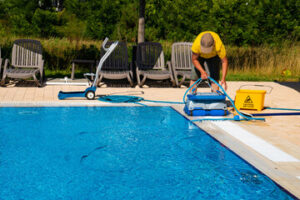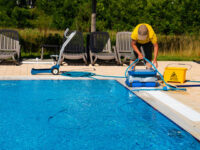How to Keep Your Pool Clean and Safe to Swim In
Keeping your pool clean and safe requires a lot of time and effort. But it doesn’t have to be costly. Here are five sustainable pro tips to help you keep your pool in top shape. Test your water chemistry bi-weekly with a water testing kit. Shock your pool at least weekly and more frequently after large parties or rainstorms. Read on Swimming Pool Service Phoenix to learn more about cleaning your pool.
 Water chemistry is one of pool maintenance’s most important and difficult aspects. Many factors can change your pool’s chemistry, and it takes practice to keep it balanced. Having the right tools and knowledge can make it much easier to manage. It’s a good idea to keep pH products, alkalinity products, and calcium products on hand as well as sanitizers. These are the basic building blocks of healthy, clean pool water.
Water chemistry is one of pool maintenance’s most important and difficult aspects. Many factors can change your pool’s chemistry, and it takes practice to keep it balanced. Having the right tools and knowledge can make it much easier to manage. It’s a good idea to keep pH products, alkalinity products, and calcium products on hand as well as sanitizers. These are the basic building blocks of healthy, clean pool water.
Chlorine is the workhorse of all swimming pool sanitizers. It’s the chemical that kills bacteria and algae, but it’s also very corrosive to equipment. It needs to be in proper balance with other chemicals in order to properly sanitize your pool water. When chlorine levels are low, it can cause cloudy water and it will be less effective at sanitizing the pool. It’s important to maintain the level of free chlorine in the pool on a regular basis.
Total Alkalinity (TA) is another important factor in the overall water chemistry of your pool. It acts as a buffer to protect the pH and should be kept between 80 and 120 PPM. When TA is too low, the pH will be erratic and hard to control. When it is high, the pH will drift upwards and can cause scaling on surfaces. There are many products on the market that can help to lower TA, but it’s always best to try to keep it in the recommended range.
Calcium Hardness is a measure of the amount of calcium in the pool water. This may vary depending on the area you live in and the source of your water. This can also be affected by rainwater, which tends to be acidic and can lower the pH. This can lead to etching and scaling on equipment and the surface of the pool. Adding calcium hardener will increase the resistance to erosion and prevent the need for frequent acid adjustments.
Water evaporation can also affect your pool’s chemistry. This is because the water that evaporates leaves behind hard-to-remove deposits of minerals and contaminants, known as Total Dissolved Solids (TDS). These can prevent your pool chemicals from working effectively and may even create stains on the walls and bottom of the pool. Adding a metal treatment, such as Suncoast’s Ultimate Metal Control Plus will reduce these metals and other minerals in your pool water.
Whether it is a pool service or you are doing DIY pool maintenance, there are many tasks that must be performed regularly to keep your swimming pool clean. The main focus of a clean swimming pool is water circulation, regular cleaning and balanced water chemistry. All of these factors work together to ensure that the water is clean, safe and ready for family fun in the sun.
Among the most important aspects of pool maintenance is skimming. Skimming the surface of your pool removes leaves, twigs, bugs and other debris that are often blown into the swimming pool by wind. This floating debris is very easy to remove with a long-handled skimmer net.
This is one of the most basic parts of a pool cleaning routine and should be done daily. In addition, it is important to empty the skimmer baskets on a regular basis. This is where the gunk gets trapped, and if it is left unattended, it can be detrimental to your pool water.
There are a few different types of pool skimmers. Some are built in, similar to a Roomba, while others require you to manually insert the net into the water and brush it across the top of the pool. You should also vacuum the bottom of your pool once a week. This will help get rid of larger debris that may be stuck at the bottom of your pool and hinder proper water flow.
It is also a good idea to clean the return and filter on your pool regularly. This will keep it clean and prevent any blockages or other issues that may arise. A simple vacuum will typically do the trick, but you can use a pool brush and a hose to get into those hard-to-reach areas.
It is very important to check your water chemistry levels a few times each week and add any chemicals as needed. The frequency of checking your water will depend on your climate and weather conditions, but it is a necessary part of the cleaning process to keep your pool clean and healthy.
The most critical part of pool maintenance is vacuuming. Vacuuming removes the fine debris from your pool water that can cause algae problems and other water balance issues. Fine matter can enter your pool from back yard trees or be brought in on swimmers feet. It can also collect on the floor of your pool where it drifts to form a layer of sediment. This needs to be removed regularly for your pool to look good and remain sanitary.
The best way to vacuum your pool is with a manual vacuum. This involves standing outside the pool with a telescopic pole that has the vacuum head attached at the end. You sweep the pool floor with long strokes of the vac, overlapping each one to get full coverage. This should be done each week as part of your routine.
If your pool has a skimmer and you use it to vacuum, make sure that the skimmer basket is clear of any debris that has collected in it. This will improve the vacuuming performance of your skimmer and prevent overtaxing your filter. If your pool is a lot larger and you can afford it, consider investing in an automatic cleaner that hooks up to your skimmer or pressure-side filter. These robots will reduce the stress on your filtration system while still allowing you to vacuum on a weekly basis.
Whether you vacuum manually or with an automatic cleaner, be sure to test the water’s pH level after each vacuuming session. Debris kicked up from the vacuuming process can alter the levels of your pool chemicals, causing problems with water balance and appearance.
If your backyard is prone to falling leaves and twigs, your pool will need to be vacuumed more often. This is particularly true during the fall and winter when your swimming pool will be covered more frequently by these items. It may be necessary to vacuum your swimming pool daily during this period.
Shocking is an important part of pool maintenance that increases the level of chlorine in your pool to destroy bacteria and other contaminants. There are several things that affect how often you need to shock your pool, including how much chlorine is in the water, the temperature of the pool, and whether you use a pool filter. The amount of people using the pool, as well as the weather conditions can also impact how often you need to shock your pool.
A good rule of thumb is to shock your pool every other week, but you can change this based on the needs of your water and how often it gets used. When your pool has a high chlorine demand, it may need to be shocked more frequently. The more people in the pool, and the more frequent the usage, the more chlorine is needed to sanitize the water.
Everything from sweat, body oils, and makeup can slough off the bodies of swimmers and alter your pool’s water chemistry. This can lead to bacteria and algae growth and exhaust your pool’s chlorine reserves more quickly. Additionally, hot, sunny weather can cause the pool to lose more chlorine than normal, further increasing your need to shock the water.
Shocking the pool drastically raises the level of chlorine in the water for a short period of time to kill off any bacteria and other organic materials that may be living in the water. This process can be dangerous if not done correctly, so it’s important to follow the instructions for your specific type of shock treatment.
There are many different types of pool shock available on the market, and each has its own benefits and drawbacks. The most common type of pool shock is calcium hypochlorite, or cal hypo, which can be purchased in either granular or tablet form. This pool chemical can be added directly to the water, but it is recommended that you pre-dissolve it in a bucket of water before adding it to your swimming pool.
Other types of pool shock include dichloroisocyanuric acid (DCA) and potassium peroxymonosufate (MPS). Both can be added to the water without pre-dissolving, but it is recommended that you use a pool brush to distribute the chemicals evenly and wait the appropriate amount of time before swimming. Be sure to wear protective gear when handling any type of pool chemicals, and always be careful not to breathe in the fumes.






